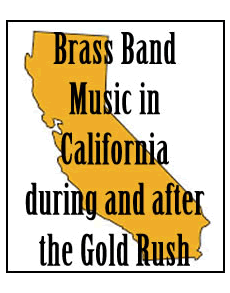
The brass band phenomenon of the Gold Rush was unique because it brought together not only American musicians and their literature, but the musical
styles and repertoire of British, German and Italian bands. It was not unusual to find these bands co-existing in the same town! They often appeared
separately at important civic and social events and even competed in annual contests. The winner of one "battle of the bands" got to keep and display
a special banner until the next contest rolled around.

In 1855, August Wetterman, a transplanted Swedish bandmaster, was hired to lead the band of the Lee and Marshall Circus which toured the mining camps twice that year.

Wetterman formed the famous
Sacramento Union Brass Band in 1856. It was engaged to accompany the city militia to San Francisco for the funeral of James King of William who had been shot by James F. Casey.

In 1857, the
Columbia Brass Band led the May Day procession to Cole's Ranch near Sonora, and later, the
Sonora (German) Brass Band under the direction of Prof. Schmitz, performed a concert with the
Sonora Glee Club. Following the concert a ball began at 6:00 p.m. and continued until four o'clock in the morning. Still today the tradition persists in Sonora of band concerts in the plaza under giant shade trees.
 Willis' Band
Willis' Band performed Gungl's Rail Road Galop in Sacramento at the Mechanics' Industrial Fair in 1869 in honor of the recent completion of the transcontinental railroad.

In 1888 the newly-formed
Young Men's Club Brass Band [of Sonora] advertised the formation of a stock company with bond offerings at one dollar per share to be redeemed at ten percent interest, per annum, in two years.

In 1890, The
Columbia Cornet Band (also know as "The Ice Cream Band") made a pilgrimage to Yosemite. They were the second band to visit the valley. While there, they played for dances and concerts.



